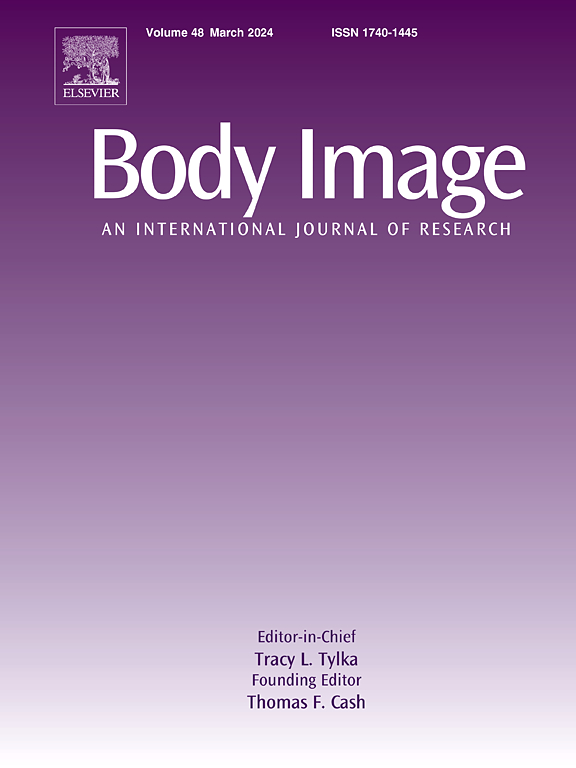比利时青少年和年轻人对社交媒体上理想化和身体积极内容的看法的定性探讨
IF 5.4
1区 心理学
Q1 PSYCHIATRY
引用次数: 0
摘要
社交媒体对青少年身体形象影响显著,但其复杂性有待进一步探讨。先前的研究往往侧重于一种类型的内容,而忽略了青少年如何同时体验有害(如理想化)和有益(如身体积极)的内容。为了解决这个问题,我们对青少年(N = 20)和年轻人(N = 14)进行了34次个人访谈(N = 14)(Mage = 18.88, SD = 2.72,女孩/女性= 19),以探讨他们对社交媒体上的外观内容的体验和对混合外观内容的认识。主题分析揭示了六个关键主题,每个主题包含子主题:(a)有害外观内容,(b)有益外观内容,(c)混合外观内容,(d)自发布行为,(e)青少年推荐,(f)平台推荐。受访者表示,理想化的内容往往会引发不健康的身体比较,但许多人淡化了它对个人的影响,认为这是一种第三人称效应,男孩和男人尤其会把社交媒体的影响降到最低。一些人,特别是那些对美的理想内化程度较高的人,由于内化的体重耻辱感,抵制身体正面内容,但大多数人对BoPo内容持积极态度。青年面临着调和理想化和bpo内容的挑战,突出了bpo信息传递一致性的必要性。此外,在探索自我发布行为时,人们对真实性有了一种精心策划的理解,即只有在符合某种视觉完美水平的情况下,真实性才会受到重视。最后,建议包括提高媒体素养、改善内容控制、删除改变外观的过滤器、推广BoPo内容以及通过算法过滤有害内容。本文章由计算机程序翻译,如有差异,请以英文原文为准。
A qualitative exploration of Belgian adolescents’ and young adults’ views on idealized and body positive content on social media
Social media significantly impacts youth body image, yet its complexities require further exploration. Prior research often focuses on one type of content, neglecting how adolescents experience both harmful (e.g., idealized) and beneficial (e.g., body positive) content simultaneously. To address this, 34 individual interviews were conducted with adolescents (N = 20) and young adults (N = 14) (Mage = 18.88, SD = 2.72, girls/women = 19) to explore their experiences with appearance content and awareness of mixed appearance content on social media. Thematic analysis revealed six key themes, each containing subthemes: (a) harmful appearance content, (b) beneficial appearance content, (c) mixed appearance content, (d) self-posting behaviors, (e) youth recommendations, and (f) platform recommendations. Respondents reported that idealized content often triggers unhealthy body comparisons, but many downplayed its personal impact, suggesting a third-person effect, with boys and men particularly minimizing social media's influence. Some individuals, especially those with high internalization of beauty ideals, resisted body positive content due to internalized weight stigma, but most viewed BoPo content positively. Youth faced challenges reconciling idealized and BoPo content, highlighting the need for consistent BoPo messaging. Further, when exploring self-posting behaviors, a curated understanding of authenticity emerged, where authenticity is valued only if it conforms to a certain level of visual perfection. Lastly, recommendations included enhancing media literacy, improving content control, removing appearance-altering filters, promoting BoPo content, and filtering harmful content through algorithms.
求助全文
通过发布文献求助,成功后即可免费获取论文全文。
去求助
来源期刊

Body Image
Multiple-
CiteScore
8.70
自引率
28.80%
发文量
174
期刊介绍:
Body Image is an international, peer-reviewed journal that publishes high-quality, scientific articles on body image and human physical appearance. Body Image is a multi-faceted concept that refers to persons perceptions and attitudes about their own body, particularly but not exclusively its appearance. The journal invites contributions from a broad range of disciplines-psychological science, other social and behavioral sciences, and medical and health sciences. The journal publishes original research articles, brief research reports, theoretical and review papers, and science-based practitioner reports of interest. Dissertation abstracts are also published online, and the journal gives an annual award for the best doctoral dissertation in this field.
 求助内容:
求助内容: 应助结果提醒方式:
应助结果提醒方式:


